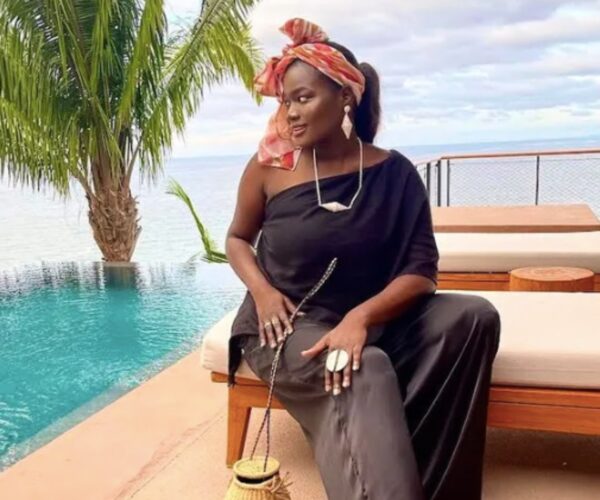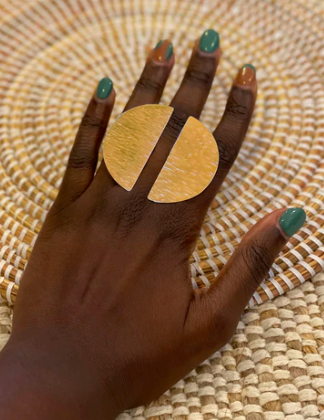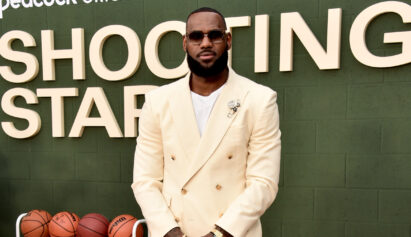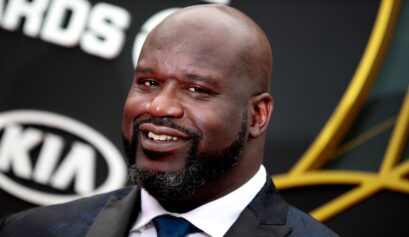African fashion designer Diarra Bousso is set to expand her successful Diarrablu empire into the accessory space, launching her first jewelry collection.
Rooted in a Senegalese and an American aesthetic, like the parent brand, each item in the collection is designed to represent the founder’s background, while simultaneously embracing new-age technology and incorporating her signature practice of adding mathematics to the mix.

Bousso and her mother, Khoudia Dionna, hired Senegalese artisans to handcraft each piece. Dionna, the brand’s Senegal director.
“On the one hand I was inspired by the traditional ornaments in Wolof and Fulani cultures and how jewelry is such an important symbol of wealth and identity,” she said to Forbes in a recent wide-ranging interview. “On the other hand, I was inspired by my own background in geometry and mathematics and wanted to explore how various polygons and circular shapes can be stacked upon one another to create unique jewelry pieces.”
Bousso is taking a unique marketing approach for her new jewelry brand: crowdsourcing.
“I have been working on it since summer 2021, and as usual I crowdsourced all the design with my Instagram audience using polls,” the designer explained to the interviewer. “I had so many designs to begin with, all over the place, and after polls I was able to narrow them to the most wanted pieces. This really helps us reduce waste and only produce what’s wanted by our customer.”
Bousso posted images of certain designs on Instagram and polled Diarrablu’s more than 75,000 followers which pieces they favored. The ones with the highest likes would be made into commercial items.
Bousso said her inspiration came from “two completely different” spaces.
The vision for the jewelry line is “aligned with the Diarrablu brand focused on oxymorons such as tradition and technology or artisans and algorithms.”
“I feel like as a Senegalese born creative,” the designer shared. “I have really learned to live at the intersection of culture, mathematics, and heritage, and realizing they are not mutually exclusive at all is truly empowering.”

This is the same philosophy she has used with her Diarrablu fashion line, which she launched her in 2015. While the brand has been successful, Bousso saw the biggest spike in sales when the police murder of George Floyd in May 2020 sparked a period of racial reckoning. As consumers sought to support Black-owned brands, Diarrablu’s sales hitting a 1,000 percent one-time high, according to Vogue Business. She even attracted media and celebrity attention, with model Kendall Jenner wearing a Diarrablu bikini in a Vogue fashion spread. But by September 2021, sales started to drop.
Still, Bousso continued to expand her brand by introducing the jewelry line.
“The business has observed tremendous growth since the pandemic,” Bousso said last month. “This year we just started a partnership with Nordstrom, after working in the past only with Shopbop and Stitchfix.”
The company has grown in the States and in Senegal. “We have grown our Dakar production workshop over three times and have created many jobs. I just hired an operations director in Senegal, as my mom could no longer handle the workload and volume,” she said.
Her staff has grown from 10 employees, to 45 people. The majority of her staff is in Dakar, Senegal. However, there are some hires who live in New York, San Francisco, São Paulo, Madrid, The Philippines, Cape Town, and in Abidjan, Côte d’Ivoire.
Working with fashions run in her family. As a child in Senegal, watched her family participate in the time-honored crafts tradition, making items in leather, metal, and jewelry. She later moved to Norway for high school and later earned a master’s degree in mathematics at Stanford University in the U.S. It was there she was intrigued by Silicon Valley and the tech world.
“I think I had a bit of an identity crisis, because Silicon Valley is all about technology, and I was a math student at Stanford with this artisan background,” she told Vogue. “I felt a sense of guilt. So when I decided to launch a line, the first thing I did was go back to the artisanal village. I spent a few weeks there just watching how they work and thought about how I could incorporate technology.”
She began with textiles and used algorithms to create silhouettes and prints. She created a digital-first, on-demand production model — nothing is made unless there was an order.
This is the same model she is suing with the jewelry line. She also carried over her mission of sustainability.
“In the West sustainability is such a trend but for us [Senegalese] it’s the status quo,” she said. “You don’t produce what you don’t need. My tailors possess ancient skills and ways of cutting based on circularity and zero waste.”




